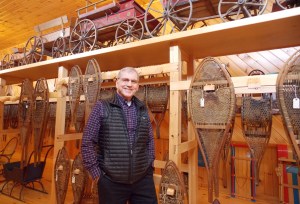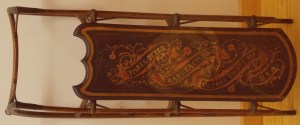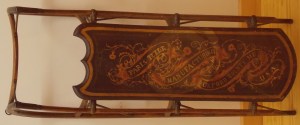OXFORD — Paul Cote knows his snowshoes. And he’s eager to share that knowledge with anyone who climbs the stairs up to the second floor of Pa’s Antique Attic to check out his collection of Maine-made snowshoes.
Cote chose the 250 pairs of snowshoes currently on display from his collection of roughly 1,500 as a representation of the many styles of snowshoes made in Maine, including those crafted in Oxford Hills.
According to Cote, Norway was once the snowshoe capital of North America. Local makers like H.H. Hosmer Co., Tubbs and Snocraft supplied retailers across the country.
“I’ve probably identified 35 Maine makers,” 25 of which can be seen at Pa’s, Cote said.
Cote acquired many of his snowshoes at auction.
Before Walter F. Tubbs became the first to mass produce snowshoes in 1907, Cote said snowshoe-making was a cottage industry that produced only a few hundred pairs a year. Crafters with seasonal outdoor jobs, like farming, would make snowshoes in their down time during the winter.
However, when outdoor retailers like Abercrombie & Fitch and L.L.Bean started to grow, they wanted a steadier supply of snowshoes. Tubbs and other companies upped production to supply the growing demand.
Some of the other companies included in Cote’s collection are C.D. Demeritt of Ketchum, Penobscot Special of Milford, Anderson and Sons of Cumberland, and Holway of Solon.
Cote also displays various Native North American-made snowshoes. He said it is difficult to distinguish the work of particular tribes, but the unique shapes and webbing indicate specific Native American designs.
One pair, called “spring snowshoes,” is almost completely round and all the webbing is contained inside the frame.
During the springtime, when a lot of melting and freezing occurs, the sharp crust created on the snow cuts the rawhide on traditional snowshoes, Cote explained. By weaving the webbing through the wooden frame of the shoes, the rawhide is protected.
Other techniques snowshoe makers would use to protect the shoes included dipping them in varnish. According to Cote, the varnish waterproofed the shoes and helped keep the rawhide webbing from sagging.
David Sanderson, local fiddler, history buff and a friend of Cote’s, said that during the winter and spring, for activities like hunting and tree-tapping, “you just used snowshoes.” Companies even made snowshoes only about a foot long for small children.
According to Cote, Snocraft, which had hundreds of forms for different styles of shoes, supplied the U.S. Army’s 10th Mountain Division with thousands of snowshoes during World War II. All of them were made in Norway.
Arctic explorers in the early 1900s also came to Maine for equipment, Sanderson said. Mellie Dunham, a well known fiddler and snowshoe maker whom Sanderson calls an “icon of rural America,” designed snowshoes for Robert Peary’s North Pole expedition in 1909.
Cote rounds out his display with a large selection of sleds and wagons made by Paris Manufacturing Co., and Withington skis and toboggans from Buckfield.
According to Cote, Paris Manufacturing Co. was an innovator in the woodworking industry, building a range of sleds and wagons.
“They did it all,” from tree to finished product, Cote said.
The wheel hub was Paris Manufacturing’s major contribution to the industry, Cote said. Other manufacturers, like Studebaker, would buy wheels from Paris Manufacturing, which knew how to dry the wooden hubs perfectly.
Sanderson believes “the history here is richer than anyone’s ever understood,” and Cote’s collection helps show that.
A lot of people here were famous — at least through their works, Cote said.
He may keep the display up longer, or reopen it later in the year, depending on public interest.
Proceeds from the weekend exhibition were donated to the Oxford Hills Food Pantry.
For more information, contact Cote at 207-743-1830.



Comments are no longer available on this story